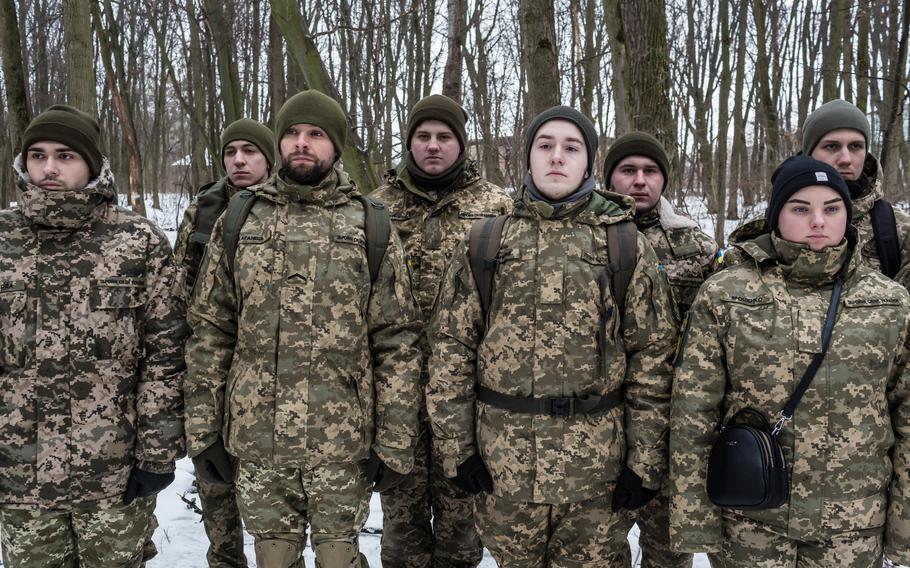
Students who are also being trained as reservists observe the training of reserve officers in the 130th battalion of the Ukrainian Territorial Defense Forces in Kyiv, Ukraine, on Jan. 22. The Territorial Defense Forces are part of the Ukrainian armed forces and include citizen volunteers. (Oksana Parafeniuk/Washington Post)
KYIV, Ukraine - Every weekend for the past three years, the reservists of Ukraine’s 130th territorial defense battalion have gathered in forests and parks on the edge of Kyiv to train for the worst: a possible full-scale invasion from Russia.
At times, this seemed an unlikely prospect. That has suddenly changed with Moscow’s troops massed on the border and Ukrainians wondering what they will do - fight, flee, hide, adapt - if Russian forces roll across it.
Kyiv’s 130th battalion is one of many such units across Ukraine. In the case of an attack, Ukraine’s government plans to provide weapons. But, for the moment, most members have obtained their own. Those who don’t have weapons train with wooden replicas.
The Washington Post got to know some of the batallion’s approximately 500 members during their recent drills in military tactics and defending strategic installations.
Oleksiy Bida, 47
Bida is from the eastern Ukrainian city of Luhansk. In 2014, after Russia annexed Ukraine’s Crimean Peninsula, Kremlin-backed insurgents took over parts of the Luhansk and neighboring Donetsk regions.
They seized Bida, who was a pro-Ukrainian activist, and held him in a cellar, where they tortured him, he said. Soon afterward, he and his wife, Yulia, fled to Kyiv. Seven months ago, the two had their first child, Simon.
Bida said that after his experiences in Luhansk and move to Kyiv, he had trouble sleeping. “I had no sense of security,” he said.
Two years ago, he met a member of the 130th defense battalion at a New Year’s party and decided to join. In the battalion, he said, he worked with people who were ready to defend “their families, homes and cities.”
This restored his sense of well-being. “I don’t have difficulty sleeping,” said Bida, now a unit leader in the 130th who oversees up to 12 fighters.
Bida was trained as a graphic designer and for a long time was a committed pacifist.
“I thought that any conflict could be resolved through peaceful means,” he said. “But I don’t believe that anymore - not with Russia.”
Maryana Zhaglo, 52
Zhaglo, a market researcher, said the defense battalion is an opportunity “not to sit on the sidelines.”
Like many of the volunteers, she took part in the country’s 2014 protests that ousted President Viktor Yanukovych and his government, which were seen as corrupt and pro-Russian. Yanukovych and a number of his ministers later fled to Russia.
During the 2014 revolution, protesters built a tent city on Kyiv’s central Maidan square with soup kitchens, first-aid points and even a chapel. They also organized into self-defense units in case officials tried to clear the square by force.
After Russia’s seizure of Crimea and the beginning of the war in eastern Ukraine, Zhaglo looked for a way to get involved.
“When the Russian aggression began, it was impossible to go out like we went to the Maidan - to put on a helmet and come to the Maidan, right?” she said, remembering the ease with which she joined the protests.
Two years ago, a friend who had joined the battalion brought her to one of its training exercises. “It happened by accident,” she said.
Zhaglo, who has two grown daughters with their own families and a son still in school, said she thinks it’s possible that Russian President Vladimir Putin will decide not to launch an attack against Ukraine.
“The situation is changing every day,” she said. “Specialists are arriving, the world community is supplying us with weapons, and everything is possible.”
“I think that now this help that Ukraine receives from all over the world, it will still play its role and Russia, perhaps, will not dare,” she said.
Iaroslav Brezytskyi, 44
Brezytskyi, a business consultant who helps companies upgrade their management methods, joined the territorial defense battalion three years ago after visiting the unit when members were practicing with weapons on one of the designated days of drills with live ammunition.
“I realized that this is exactly what I need. I can be a civilian and earn money for my family, pay taxes, [and at the same time] help as a volunteer in the army and gain military knowledge,” he said. “That was the day when I joined the territorial defense mentally.”
The battalion also offered Brezytskyi a way not to feel sidelined.
“Prior to [joining], I could not get rid of the feeling that I am not involved in Ukraine’s war of liberation against Russia,” he said. “Now, throughout these three years, we have training on a weekly basis, we obtain new knowledge and know-how.”
“I hope [these] will become useful, if Russia keeps escalating the events in Ukraine,” he said.
Brezytskyi said he bought his own weapon, a U.S.-made AR-15-style semiautomatic rifle, for about $800.
“Each fighter tries to provide himself with his own weapon, but it is not cheap and not everyone can afford it,” he said.
In all, he said, he has spent “very roughly” between $1,700 and $2,100 on weapons and equipment. But some items, such as body armor with ceramic plates instead of the less-effective metal ones that he has, are “a dream more than reality.”
“It is very difficult, of course. The priority is the health of parents, loved ones, your wife and children, their needs,” he said. “If there is a war, then we will fight it with what we have.”